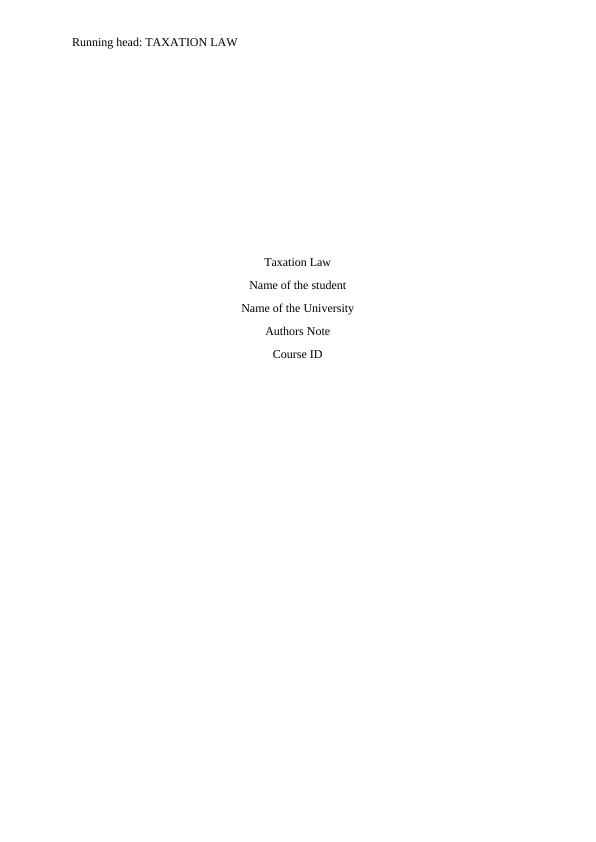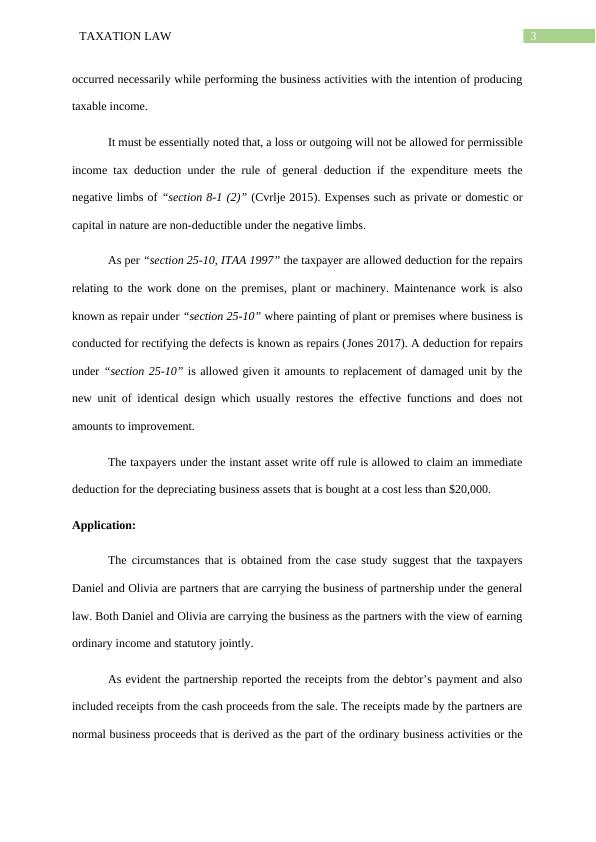Taxation Law Case Study: Determination of Partnership Net Income, Expenses, and Deductions
Added on 2023-04-25
13 Pages2530 Words341 Views
Running head: TAXATION LAW
Taxation Law
Name of the student
Name of the University
Authors Note
Course ID
Taxation Law
Name of the student
Name of the University
Authors Note
Course ID

1TAXATION LAW
Table of Contents
Answer to question 1:.................................................................................................................2
Answer to question 2:.................................................................................................................8
References:...............................................................................................................................11
Table of Contents
Answer to question 1:.................................................................................................................2
Answer to question 2:.................................................................................................................8
References:...............................................................................................................................11

2TAXATION LAW
Answer to question 1:
Issues:
The main issues that the current case study is concerned relates to the determination
of the net income of the partnership within the meaning of “section 90, ITAA 1936”.
Rule:
An explanation has been made under the “division 4 of the ITAA 1936”, which
clarifies that the partnership is not treated as the separate legal entity under the meaning of
general law and no taxes is paid by the partnership. The partners are required to pay taxes on
the distribution of profits that is made (Ismer 2016). As per the section 91, an income tax
return must be lodged by the partnership to determine the amount of profits that is distributed
to the partners. According to “section 995-1, ITAA 1997” the partnership refers to the
carrying the business as the partners with the view of earning ordinary income and statutory
jointly.
A receipts is regarded as the normal business proceeds that is derived as the part of
the ordinary business activities or the ordinary incident of business. According to “section 6-
5, ITAA 1997” ordinary income constitutes the gains that originates from carrying on the
business activities (Kasper et al. 2017). In order to characterise the receipts as the normal
proceeds of the business it is necessary that the receipts forms the normal proceeds of the
business activity.
“Section 8-1, ITAA 1997” forms the main provision that provides the taxpayers with
the general deduction for the expenses (Hickman 2017). A taxpayer is permitted to claim
deduction from their taxable income under the general deduction provision of “section 8-1,
ITAA 1997” given the expenses are occurred in gaining or producing the taxable income or
Answer to question 1:
Issues:
The main issues that the current case study is concerned relates to the determination
of the net income of the partnership within the meaning of “section 90, ITAA 1936”.
Rule:
An explanation has been made under the “division 4 of the ITAA 1936”, which
clarifies that the partnership is not treated as the separate legal entity under the meaning of
general law and no taxes is paid by the partnership. The partners are required to pay taxes on
the distribution of profits that is made (Ismer 2016). As per the section 91, an income tax
return must be lodged by the partnership to determine the amount of profits that is distributed
to the partners. According to “section 995-1, ITAA 1997” the partnership refers to the
carrying the business as the partners with the view of earning ordinary income and statutory
jointly.
A receipts is regarded as the normal business proceeds that is derived as the part of
the ordinary business activities or the ordinary incident of business. According to “section 6-
5, ITAA 1997” ordinary income constitutes the gains that originates from carrying on the
business activities (Kasper et al. 2017). In order to characterise the receipts as the normal
proceeds of the business it is necessary that the receipts forms the normal proceeds of the
business activity.
“Section 8-1, ITAA 1997” forms the main provision that provides the taxpayers with
the general deduction for the expenses (Hickman 2017). A taxpayer is permitted to claim
deduction from their taxable income under the general deduction provision of “section 8-1,
ITAA 1997” given the expenses are occurred in gaining or producing the taxable income or

3TAXATION LAW
occurred necessarily while performing the business activities with the intention of producing
taxable income.
It must be essentially noted that, a loss or outgoing will not be allowed for permissible
income tax deduction under the rule of general deduction if the expenditure meets the
negative limbs of “section 8-1 (2)” (Cvrlje 2015). Expenses such as private or domestic or
capital in nature are non-deductible under the negative limbs.
As per “section 25-10, ITAA 1997” the taxpayer are allowed deduction for the repairs
relating to the work done on the premises, plant or machinery. Maintenance work is also
known as repair under “section 25-10” where painting of plant or premises where business is
conducted for rectifying the defects is known as repairs (Jones 2017). A deduction for repairs
under “section 25-10” is allowed given it amounts to replacement of damaged unit by the
new unit of identical design which usually restores the effective functions and does not
amounts to improvement.
The taxpayers under the instant asset write off rule is allowed to claim an immediate
deduction for the depreciating business assets that is bought at a cost less than $20,000.
Application:
The circumstances that is obtained from the case study suggest that the taxpayers
Daniel and Olivia are partners that are carrying the business of partnership under the general
law. Both Daniel and Olivia are carrying the business as the partners with the view of earning
ordinary income and statutory jointly.
As evident the partnership reported the receipts from the debtor’s payment and also
included receipts from the cash proceeds from the sale. The receipts made by the partners are
normal business proceeds that is derived as the part of the ordinary business activities or the
occurred necessarily while performing the business activities with the intention of producing
taxable income.
It must be essentially noted that, a loss or outgoing will not be allowed for permissible
income tax deduction under the rule of general deduction if the expenditure meets the
negative limbs of “section 8-1 (2)” (Cvrlje 2015). Expenses such as private or domestic or
capital in nature are non-deductible under the negative limbs.
As per “section 25-10, ITAA 1997” the taxpayer are allowed deduction for the repairs
relating to the work done on the premises, plant or machinery. Maintenance work is also
known as repair under “section 25-10” where painting of plant or premises where business is
conducted for rectifying the defects is known as repairs (Jones 2017). A deduction for repairs
under “section 25-10” is allowed given it amounts to replacement of damaged unit by the
new unit of identical design which usually restores the effective functions and does not
amounts to improvement.
The taxpayers under the instant asset write off rule is allowed to claim an immediate
deduction for the depreciating business assets that is bought at a cost less than $20,000.
Application:
The circumstances that is obtained from the case study suggest that the taxpayers
Daniel and Olivia are partners that are carrying the business of partnership under the general
law. Both Daniel and Olivia are carrying the business as the partners with the view of earning
ordinary income and statutory jointly.
As evident the partnership reported the receipts from the debtor’s payment and also
included receipts from the cash proceeds from the sale. The receipts made by the partners are
normal business proceeds that is derived as the part of the ordinary business activities or the

End of preview
Want to access all the pages? Upload your documents or become a member.
Related Documents
Taxation Law: Determination of Net Income of Partnership and Fringe Benefit Taxlg...
|13
|2614
|270
Taxation Law: Partnership Net Income and Expense Payment Fringe Benefitlg...
|12
|2661
|103
Taxation Law Assignment: Net Income of Partnership and Fringe Benefit Taxlg...
|12
|2624
|156
TAXATION LAW Taxation Law Name of the University Authorslg...
|13
|2737
|310
Taxation Law: Partnership Net Income and Fringe Benefits Taxlg...
|12
|2589
|64
Taxation Lawlg...
|10
|2114
|297
